Age of Mythology Preview
We travel to Dallas and get a first-hand look at Ensemble's upcoming 3D RTS.
In a span of only a few years, Ensemble Studios has conquered the gaming world with its high-quality Age of Empires real-time strategy series. For the past three years, the company has been enriching the genre with its historical, real-world RTS, but soon, Ensemble will be unleashing an entirely new type of real-time strategy game on the public. Many will be quick to label it a fantasy game, especially considering that it offers units such as giants, trolls, and griffons, but to call it such would be a disservice to the ambitions and efforts of the design team.
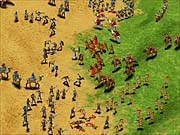
Ensemble Studios' follow-up to Age of Kings isn't a direct sequel, even though it builds on the successes of its Age predecessors. It also won't be a fantasy game, despite some fantastic elements. Instead, the designers at Ensemble are dubbing it a mythology game and calling it Age of Mythology, a game of gods and of the civilizations that worship them. The distinction might be slight to some, but as you dig deeper into Age of Mythology, you'll find that it isn't just semantics. Indeed, this game isn't about spells and monsters, but about ancient civilizations and the fact that their entire world view was shaped by what they believed were heavenly forces made manifest on the earthly plane. Early man would see a comet and draw divine purpose from its being or witness a storm of lightning and fear the gods' wrath. The gods were called on daily to bless labor, love, and war. Ancient civilizations could not help but ascribe divine meaning to everyday occurrences, investing them with mythology properties. And Ensemble's new game, Age of Mythology, seeks to re-create this feel by making the presence of the gods felt from the beginning of gameplay.
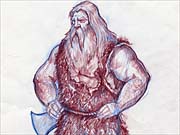
In many ways, Ensemble's new game looks similar to Age of Kings. But it is different enough to not be a sequel. According to Codesigner Ian Fischer, they want to keep the gameplay that made Age fun, but also do things differently. "We wanted to give people a new gameplay experience. And mythology lets us do that," he says. By adding the presence of gods and mythology, they are doing just that. Functionally, Age of Mythology will play much like Age of Kings and other RTS games. You start from a small town center and build up to an empire, exploring the world and dominating your rivals. But in Age of Mythology, through it all, you'll be calling on the gods for divine inspiration and intervention, whether it's to bless your crops, send you mythological troops, or smite your enemies with fire from the heavens. It's this latter aspect, this fantastic element of divine intervention, that really makes Age of Mythology stand out, and it should make it a much more exciting game than its already great predecessors.
Recently, GameSpot visited the headquarters of Ensemble Studios in Dallas, Texas, to get an exclusive look at its next offering. Age of Kings was a universally lauded game, and it will take an incredible effort to exceed it, but from what we saw, Age of Mythology should do just that. We got an exclusive look at the new 3D engine for the game, the improvements to game design, the unique civilizations, the three pantheons of gods that influence the gameworld, and a whole host of other game features. Over the next few months, we'll be taking a closer look at the nine different civilizations with individual civilization showcases. But first, we begin with a full preview of the overall game.
A New Look
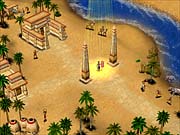
Ensemble Studios has actually been working on the new 3D engine for Age of Mythology for nearly four years. Right after the first Age of Empires shipped, Dave Pottinger, the technology lead at Ensemble Studios, began work on a 3D engine for a new game. Even as Age of Empires II was designed and completed, work continued on the engine. When Age of Kings shipped, full design on the next Ensemble game hit full stride, and ideas were thrown around to create a game around the nearly complete 3D engine.
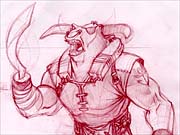
After intense months of debate, including a roundtable discussion during which more than 200 ideas were offered, the design team decided to create a game based on mythologies and ancient religions. It wanted to create a gameworld that could be shaped and molded in real time, with 3D units that were highly detailed and intricate. But Ensemble also wanted the same frenzied battles with hundreds of units, but now with 3D graphics. Pottinger's new engine enabled the designers to do all of that--to have deformable terrain, 3D units, and still maintain battlefields with hundreds of battling units, if not more.
We visited Ensemble just after the team put the finishing touches on their E3 build, which will be shown at this week's E3 show, and from what we saw, the game looks amazing. Fischer says that Ensemble's goal from the beginning has been to achieve photo-realistic graphics, and that goal has been achieved admirably. The graphics in the game are great, and the game isn't even done yet; there is still more than six months to go, during which the engine will continue to be tweaked for better performance and some graphic updates. But even now, the game looks wonderful. The terrain is detailed and realistic, and there are undulating dunes of sand, craggy cliffs, and snowy hills and shining glaciers. When units walk across the desert or snow, they leave footprints. When the rippling ocean waves lap onto the sandy beaches, they darken the sand and leave trails of foam. Snow falls gently, drifting side to side as it lands on the ground. Wind causes trees to sway and waves to swell. The world in Age of Mythology just seems alive. And with the dozens of new animals populating the terrain--including bears, crocodiles, hippos, gazelles, lions, giraffes, zebras, boars, goats, and more--Age of Mythology's environments seem more rich than ever before. The programmers also added day and night lightning and all grades in between. You can adjust the time and have an inky-black night, smoldering red sunsets, and bright daytime light. As you rotate the world, shadows will change to reflect the new direction. This game actually models the rising of the sun in the east and the setting of the sun in the west, and the shadows will change to reflect the movement of the sun.
Because of the 3D graphics, the gameworld is incredibly detailed. When standing in the snow, units expel frosty breath. When standing idle, they rub their arms and shiver in the cold. Units in the hot desert wipe their brows. As farmers walk through cornfields, they push past the corn stalks, which wave back and forth as they walk through. When buildings are destroyed, their columns topple inward, and roofs collapse. When storms cause lightning to hit buildings or land, fires will spring up exactly where the lightning bolt hit. The detail even extends to representing each unit's upgrades onscreen. When you research upgraded iron shields, your units actually sport shining iron shields. When they get better swords, you see them wielding the same swords you just researched. Because the programmers can attach objects in real time to units, you'll see each upgrade appear on the units. Visually, you'll always be able to tell just how advanced your opponent's troops are--and vice versa.
Sweeping Improvements
The 3D engine goes a long way in showing that Age of Mythology is not a sequel or an upgrade. But the many enhancements in game mechanics also show that Ensemble is really making this game better than its predecessors in every way. The interface is changing to make it even easier for new gamers to play this game. One of the interface enhancements includes moving the idle villager button to the top of the screen to make it more noticeable. Also, you'll get one tab for each idle villager you have. As more villagers become idle, more tabs will stack under each other so that you get a quick visual indicator of how many people are slacking off. Another enhancement is the set of nine tabs on the top left of the screen. These are numbered, and they let you create quick groupings for your units. While you can still create groups with the Ctrl+number keys, you can now simply group a bunch of units and click on one of the nine tabs, which sets the units into that grouping. The tab will also change into a bow, sword, or horse to indicate what units make up the majority of the grouping. It's a minor enhancement, but it makes unit management even easier.
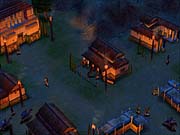
Multiplayer will also be enhanced. Matchmaking on the Internet Gaming Zone will be easier now, rather than through an external browser. The scenario editor will also be run in the game, rather than with a separate executable. The random map scripting will be better, and the game will now run an error check after it builds the random map, something it didn't do in the Age of Empires games.
One very big change in Age of Mythology is the greater emphasis on the single-player campaign. Fischer admits that the campaigns in Age of Empires I and II left much to be desired. But in Age of Mythology, Codesigner Greg Street says they plan to create a real story, with plot twists, interesting characters, and varied emotions. You'll start as a hero, who must complete a variety of quests that will carry him across the Old World. Ensemble is weaving ancient stories and mythologies into this campaign. For instance, you'll help in the siege of Troy, meet with Odysseus, and travel to Egypt and gather the body parts of Osiris so that you can resurrect the slain god and even journey into the Underworld of Hades.
There will be one campaign, not several, but you will be able to play with all the game's cultures during the single campaign. Rather than have mission briefings that take you out of the game, the entire campaign will be seamless. Mission briefings will instead be given with in-game cinematics. For example, in the demo we saw, our first order was to ride into town. As soon as we did that, the camera perspective changed, and the screen turned to letterbox format. Our hero dismounted and was told by his lieutenant that his men were waiting just beyond the town for him. The cinematic ended, and we were again given control of the hero. When we rode to the town outskirts to address the men, another letterbox movie played, and the hero gave a speech to his men. Then the movie panned to an enemy army on a nearby hill, led by a huge cyclops. The hero vowed to destroy the cyclops in single combat, and again, the movie ended and we resumed control. Once we confronted the cyclops and killed him, we were given another objective via a movie. Street says that this time, Ensemble will create a more interesting campaign, and there will be campaign-only elements, such as terrain, units, and other goodies to make playing the campaign worthwhile, aside from the promised story and characters.
The Gods in Age of Mythology
Where Age of Mythology really shines is in its mythology component. As we mentioned before, this isn't a fantasy game in which you churn out legions of trolls and giants and wage war with spells. Instead, you curry favor with the gods through worship and are rewarded for your devotion with special powers and followers. The game features three cultures--Egyptians, Greeks, and Norse--each with its own set of gods that it worships and its own list of units and buildings it can construct. Of course, the art looks different-- from the buildings to the units--for each culture. In each culture, there are three major gods. For the Egyptians, the three main gods are Ra, Osiris, and Set. For the Greeks, they are Zeus, Poseidon, and Hades. For the Norse, they are Odin, Thor, and Loki.
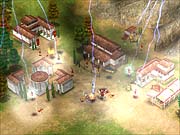
When you begin the game, you choose which one of the three main deities you will worship after selecting your culture. He becomes your primary deity, and thereafter, your civilization is determined by this choice of worship. Thus, there are nine civilizations in the game, based on the nine possible patron deities. Each god gives his civilization a different set of bonuses, and where applicable, these bonuses are tied to the god's powers. According to Norse mythology, Odin, for example, is the all-seeing god who uses his two ravens to scour the world for news. Thus, if you choose him as your deity, one of your bonus abilities will be the ability to see more of the world map. And many of the powers and creatures you can summon later in the game will depend on your choice of god as well. For example, Zeus, and only Zeus, grants you the power to summon lightning storms. Of course, each civilization also grants abilities that are more secular. For instance, the Loki civilization gets a +10 attack bonus for archers, while other civilizations might get stronger chariots or faster farming capabilities.
Your culture and civilization also determines what type of hero you can build. Heroes are a new type of unit in Age of Mythology, with greater attack and defense than normal units. Each civilization's hero unit is a little different, but all are equally powerful and important. Each culture will get heroes in different ways. The Egyptians, for instance, will start with a hero. The Greeks will have to create heroes at their town center. The Norse won't build heroes but will instead get to create them when regular units fight in battle. When one unit accumulates enough kills, you'll be able to upgrade it to a hero. The designers are considering having different ages yield different types of heroes, such as an archer hero, an infantry hero, and a cavalry hero. The plan right now is that heroes will at least get extra hit points and stat boosts when you advance in age. After all, they are important units that you want to keep with you as you advance through the game. In addition, the heroes will be different, depending on your civilization and culture. We don't have the details yet, but we will have them when we unveil each civilization showcase. What we do know is that for now, the plan is to allow the Egyptians only one hero and to allow the Greeks and Norse to build multiple heroes. To make up for the deficiency, the Egyptian hero will of course be more powerful.
Heroes won't gain experience. Ensemble toyed with the idea but decided this was a strategy game and not an RPG. However, heroes are vitally important because they are the only units that can call god powers, Age of Mythology's version of powerful spells. God powers are but one of several ways that your worship of the gods manifests itself physically in the gameworld. Heroes are your connection to this divine power in Age of Mythology and, as such, require a little divine favor when being built.
The Favor of the Gods
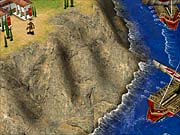
Favor is the new resource in Age of Mythology. You still have to gather food, gold, and wood, but favor is now required to access the mythological component of the game. Once you choose a patron god and build temples, you can start accumulating favor. Unlike other resources, though, favor is capped at 100. Even if you continue worshipping past that number, you won't get any more. That's because Ensemble wants you to keep spending your favor to gain special abilities and mythological creatures; you're not meant to hoard it. Also, the mythological creatures and powers you gain from favor are meant to be rare. Hence, the more limited supply of favor. Favor, like heroes, is gathered differently depending on which culture you play. The Egyptians gain favor by building monuments to their gods. The Greeks gain favor by praying at temples with villagers. The Norse gain favor by killing enemies in battle.
Favor is used as a resource for three things: to buy mythological units, to get mythological improvements, and to gain god powers. Mythological units are the creatures of legend that you can summon once you have built temples to the gods. They are unique to the different cultures. For instance, the Greek mythological units include such legendary creatures as minotaurs, cyclopes, and medusas. The Norse mythological units include frost giants, fire giants, and trolls. Egyptian mythological units include mummies and anubites (the dog-headed humanoids featured in The Mummy Returns). While these mythological units will be powerful, they are more specialized than you'd expect. You aren't meant to churn out 50 fire giants and storm into an enemy's town. Instead, many of these mythological units will be support units. The Norse frost giant, for example, is a lumbering behemoth, but it can't kill units. Instead, its icy breath freezes nearby units, encasing them in tombs of ice. They are then immobilized and easy pickings for your infantry. Ensemble wants the power of the gods, including mythological units, to be rare and special. Thus, you aren't meant to have an army of infantry, archers, and some siege engines backed up by cyclopes or giants. Of course, some mythological units will be generalist units, able to kill enemies directly, but for the most part, either sheer expense or design will make mythological units a complement rather than a replacement for your regular army.
While regular units, such as archers and cavalry, are built at their normal buildings (like the archery range or stables), the mythological units are built at temples. They cost both favor and regular resources to build (in this instance, the designers refer to the material resource as a sacrifice). Each creature is keyed to a different temple. So the creatures you can build depend on which temples you build. And those temples available to you are in turn determined by who your main deity is. Each culture has a pantheon of nine or so gods. Thus, while the three main Greek gods are Zeus, Poseidon, and Hades, there are nine other gods under them--among them Ares, Aphrodite, Athena, Haphaestus, and Dionysus (god of wine). However, not all these gods are available to you. Ares, for instance, might be available only to a Zeus or Hades civilization, while Aphrodite might be available only to Zeus and Poseidon. Thus, while the Greek culture itself has a range of 10 or so mythological creatures, each civilization might have access to only six or so of these creatures because certain gods are denied them. And like other units, the more powerful mythological units become available only in later ages, when the proper temple is built.
In addition to mythological units, favor can also be used to purchase divine improvements. There are roughly 10 or so divine improvements per culture, again divided amongst the different civilizations by temples and age. These improvements are one-time bonuses, like a bonus to crop production or a bonus to building speed. In effect, you are spending your favor with the gods to garner divine enhancement to your economy and production.
Godly Powers
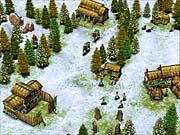
The last way that you can spend favor is by calling for god powers. When you use a god power, a shining light beams down from the heavens over your hero, and after a few seconds, the god power is unleashed. In the demo we saw, there were only two god powers: meteor and lightning. With meteor, several fiery rocks stream down from the sky and pound the ground, killing any nearby units and creating smoking craters. Finally, a huge meteor plummets down and creates a massive explosion that engulfs the entire screen in fire, leaving a massive crater that takes up half the screen. Lightning, in contrast, isn't nearly as visually spectacular. When lightning is called, the skies darken and rain starts to fall, as forks of lightning streak down from the dark clouds and blast terrain and enemy units.
Again, as with the mythological creatures, this manner of divine intervention is supposed to be a boon from heaven, a favor that you ask for, rather than some spell you can direct personally. Thus, when you spend favor to call a god power, you can't designate the target of this power. Instead, showers of meteors plummet down around you, and you won't know exactly where they hit, although the meteors won't harm you or your troops (the gods are, after all, on your side). All god powers, thus far, are centered on your hero, so you'll always need to move your hero to the target of your god power. You can't hurl lightning bolts with impunity from afar. You'll need to call the god power and then move your hero into your enemy's ranks if you want the lightning bolts to hit your enemy's troops and buildings. Nor can you target specific enemy units. Instead, lightning bolts rain down around you to blast random enemy troops. Ensemble implemented god powers this way for two reasons. First, it reinforces the idea that the gods help you at their discretion, not yours. Second, it balances the power of the god powers by requiring that you put your hero in mortal danger to pull off these pounding attacks. It makes the god powers a tactical risk, but with a big reward. And it also means your opponent has a fighting chance to stop the god power before it is unleashed--by killing your hero first.
Although we saw only two god powers, Fischer says there will be many other god powers, such as earthquake, healing, and protection. There are plans for a god power that lets you summon wild animals you can't control but that attacks all nearby units. Ensemble is also toying with the idea for a rainbow bridge god power, based on the Norse myth of a rainbow bridge that connected the gods' home of Asgard with Midgard or the earth. This Norse god power would create a rainbow bridge that could be used to cross rivers and impassable terrain. One Egyptian god power is shifting sands, which is basically a mass teleport to transport units via swirling sands to anywhere on the map. Yet another god power is frost storm, which will freeze buildings and units. Frozen buildings will stop their production, and frozen units won't be able to move or act.
These god powers will be distributed among the three ages, with the more powerful ones, like meteor, being held to later ages, and the lesser powers, like healing, offered immediately in the first age. There should be about 10 or so powers per culture, although because each is tied to a different temple, each civilization won't get every god power available to its culture. In addition, because god powers cost favor, and favor is capped at 100, you won't be able to use your god powers too frequently. These god powers are meant to be used only once in a long while, and often you'll have to choose between using favor to get permanent mythological troops or spend them on one-time god powers.
Deep Changes to Gameplay
In addition to the emphasis on mythological creatures and divine intervention, there are other big changes in Age of Mythology. The game will still have age progression, but there will be three ages in the game instead of four. Ensemble says that in analyzing multiplayer Age games, it found that most games simply devolved into a race to see who could advance to the later ages fastest. The winner was whoever advanced fastest and deployed an army of more advanced units, like heavy cavalry.
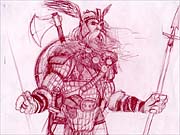
Ensemble has thus done a few things to make the game more balanced and fun throughout the ages. The first and second ages have been combined into one age. This gives you more options during the first age in terms of gameplay. Even in the first age, you'll be able to build temples, create mythological units, and call on god powers. In addition, attacking during the first age won't be as useless as it was in Age of Kings, where the power of the town halls was so great in proportion to your unit strength in the first age as to make early offensives all but worthless. In Age of Mythology, with more units to build and more options, early attacks will be more viable.
In addition, Ensemble is making some aspects of gameplay age-independent so that players aren't as disadvantaged when they are stuck in earlier ages against more advanced opponents. Unit types, for example, are age independent. So even in the first age, if you had enough resources to research and then buy them, you could create heavy cavalry. However, upgrades, such as better armor and weapons, are still age dependent, so you would still have to advance to later ages to get the most out of your heavy cavalry. And of course, many myth units, god powers, technologies, and buildings are keyed to different ages, so there is still as much incentive as before to advance to higher ages. However, now, there is also incentive to hold off on racing up the age ladder. For instance, you need to build a temple to advance to the next age. One player can opt to build just one temple so that he or she can advance to the next age and gain technological superiority. But another player can opt to stay in the current age and use his or her resources to build many temples to gain more mythological power. By tying more abilities to temples and adding more options in the first age, Ensemble is making it viable for players to stay and explore the capabilities of an early age.
In addition to balancing out the ages, Ensemble is changing the way naval combat works. Now, instead of many different ships, there will probably be one ship type per civilization. The ships in turn will change depending on what you put on it. If you put siege weapons on the ship, it will become a siege ship. If you load the ship with archers, it will become a warship. If you put infantry on the ship, the infantry will become oarsmen (and you'll see the ship suddenly sprout dozens of oars), thus making it faster. Ships are thus now more like floating castles or towers. Rather than being separate units themselves, they conform to the units you place in them, becoming speedy transports, sluggish siege engines, or powerful warships at your choosing.
These are not the only features and enhancements to be found in Age of Mythology, but they are the most notable and striking features we've seen thus far. There is still a lot more to discuss regarding this incredible game, much more than we could fit in this one preview. That's why in the coming months, we'll be bringing you regular updates and civilization showcases, detailing the new units, mythological creatures, god powers, and more. Keep coming back as we unveil more information on what promises to be a revolutionary next step in Ensemble's Age series of real-time strategy games.
Got a news tip or want to contact us directly? Email news@gamespot.com
Join the conversation